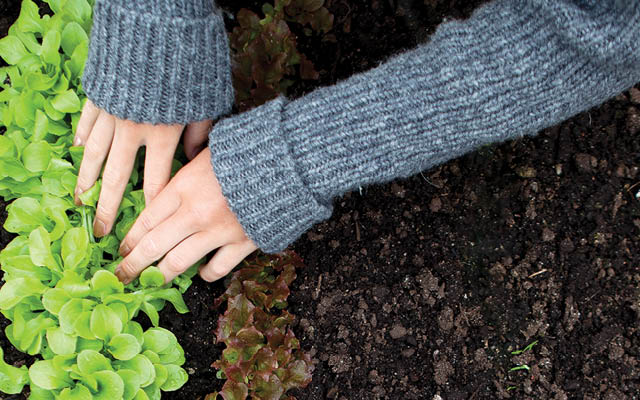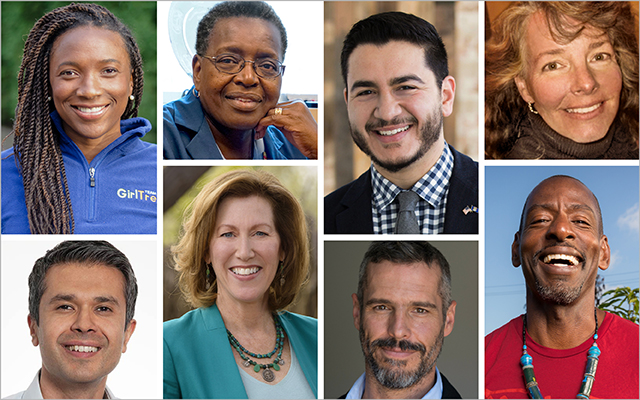One evening last summer I walked to a neighbor’s house to deliver a bag of beautifully ripe pears, which another neighbor had picked from her tree the day before. I had just finished dinner, which included sweet corn from another neighbor’s garden, along with a salad made with vegetables from my own. I was also the beneficiary of fresh eggs from the same pear-providing neighbor, plus peonies from a friend who grows more than 200 varieties in her suburban yard.
I swelled with pride for this little co-op we had going. I loved being on the receiving end, but I felt just as good about sharing the abundance from my own garden.
An enthusiastic exerciser, I recognized the feeling, which was akin to an endorphin high. Among its many health benefits, gardening strengthens your body and lifts your mood.
That’s motivation enough to get my hands in the dirt, but the connection with my neighbors seemed to amplify those rewards. It’s like how I feel after a group run: The workout itself is good for me, but I get a little something extra when I’m joined by friends.
Coming Together
Although I hadn’t considered my backyard a “community garden,” the fact that my neighbors and I were connecting over the fruits of our labor made it so.
“All community gardens are sharing gardening,” says Cathy Walker, president of the American Community Gardening Association. “They come together to provide food for their families, neighborhoods, and others.”
The more traditional community garden generally refers to a parcel that’s subdivided into small plots where people can cultivate vegetables and flowers for their personal use with permission from city officials or property owners. This shared space unites neighbors with a common goal.
[A community garden] offers a place where people can come together to improve their quality of life.
Other examples include school gardens, which serve as educational tools, and healing gardens, which are often cultivated near healthcare facilities to provide therapeutic green space for patients, families, and staff. There are even “guerrilla gardening” projects — where gardeners descend on a dilapidated public space to turn it into something vibrant and gorgeous.
“Community gardening is more than planting a seed and watching it grow,” Walker explains. Rather, it offers a place where people can come together to improve their quality of life. Community gardens, she says, grow people.
Good Moods in Bloom
It’s a concept with deep historical roots. “Most people do not realize that community gardens were established in the 1800s in the United States,” Walker notes, adding that Americans have long used gardening as a tool for unification and problem-solving.
Perhaps the most well known of these projects are the World War II victory gardens, planted to support the war effort by supplementing food rations. Many of them are still thriving.
And while community gardening provides myriad benefits — offering a local food source, reducing food insecurity, promoting nutrition education, encouraging physical activity, and more — experts believe the reason for their enduring popularity is much simpler: It just feels good.
“Gardening is good for the soul,” says Jim Guckert, founder and executive director of Guerrilla Gardeners of Washington, D.C. “It’s meditative and contemplative. Nothing grounds a person like getting your hands dirty.”
In the words of writer Anne Lamott, “Air and light heal.” The very things that are good for gardens are also good for people. During the coronavirus pandemic, community gardening has offered space to receive both and still practice social distancing.
Feed the Need
Gardens have also become integral to racial-justice protests and memorial sites. At George Floyd Square in Minneapolis, volunteers constructed a greenhouse and raised vegetable beds along the sidewalks. Flowers planted at the center of the intersection encircle a sculpture of a raised fist.
The garden honors the space as well as the people afflicted by the collective trauma. And the healing extends to better nutrition for the community.
The garden honors the space as well as the people afflicted by the collective trauma.
The Chicago-based Urban Growers Collective, a BIPOC women–led organization, operates eight urban farms on 11 acres of land predominantly located on the city’s South Side. They provide employment for youth, better access to fresh food, and market opportunities for farmers. These farms also support health, economic development, and education efforts in communities of color.
“Urban Growers Collective’s COVID-19 emergency-food-response efforts include working with our squad of BIPOC-led partner organizations to distribute produce boxes and prepared meals to community members in need,” says cofounder Laurell Sims. “Not only does our squad meet the immediate needs of communities, it directly supports BIPOC businesses by allowing them to safely grow, process, prepare, and distribute high-quality, nutritious meals and produce boxes.”
Between January and August of 2021, Urban Growers Collective’s Fresh Moves Mobile Market distributed free-produce vouchers worth a total of $100,460 to community members affected by the pandemic, as well as 3,635 boxes of produce and some 4,000 hot meals.
“We know that healing cannot happen when basic needs are not met,” Sims says. “And our first line of defense to help promote healing is nutritious food in historically divested communities.”
Seeds of Change
People join community gardens for a variety of reasons, Walker explains: to combat loneliness, to improve health, to network and socialize, to gain gardening skills, or just because.
Guckert started guerrilla gardening 18 years ago, tending a small, neglected park across the street from his home, which happened to be adjacent to the first U.S. Marine Corps post. Although he considers himself a “lone ranger,” Guckert has mobilized some 125 like-minded gardeners in the D.C. area. In 2020, volunteers logged more than 1,500 hours of service. In 2021, they had accumulated 1,400 by August.
“Capitol Hill is a generally upscale neighborhood with pockets of underserved populations,” he notes. “We focus on the green spaces most in need of beautification.”
“There is always a friend in the garden.”
Although these Guerrilla Gardeners don’t seek permission to transform and maintain these spaces, public officials praise their work, and city agencies now collaborate with them to sustain the results. “I feel rejuvenated in the spring when I see bulbs I planted break through the soil — and sometimes the snow,” Guckert says.
Doing good begets feeling good. And positive action in your community offers innumerable benefits beyond the boundaries of the garden.
Chief among them is human connection. “Community gardening gives you a chance to get to know your neighbors as equals,” Walker says. “Mother Nature does not see skin color, language barriers, education level, or where we come from. There is always a friend in the garden.”
Growth Opportunities
Want to participate in community gardening but don’t know where to start? These ideas can help you get going.
- Share the Bounty from your own garden — whether it’s a sprawling backyard plot or a few pots on your balcony — with your friends, neighbors, or local food shelf.
- Look for existing gardens that need volunteers. Some schools, hospitals, and places of worship grow vegetable gardens that require helping hands.
- Check with your city to see if it offers plots to rent in a locally sponsored community garden.
- Be on the lookout for neglected parcels of land that need beautification. Consider adopting the credo of the Guerrilla Gardeners of Washington, D.C.: “We don’t ask, we act!” In 15 years of guerrilla gardening, founder Jim Guckert reports, never once have they been asked to stop.
- Start your own community garden by following the steps outlined by the American Community Gardening Association at www.communitygarden.org/resources.
This article originally appeared as “Grow Your Community” in the March 2022 issue of Experience Life.





This Post Has 0 Comments